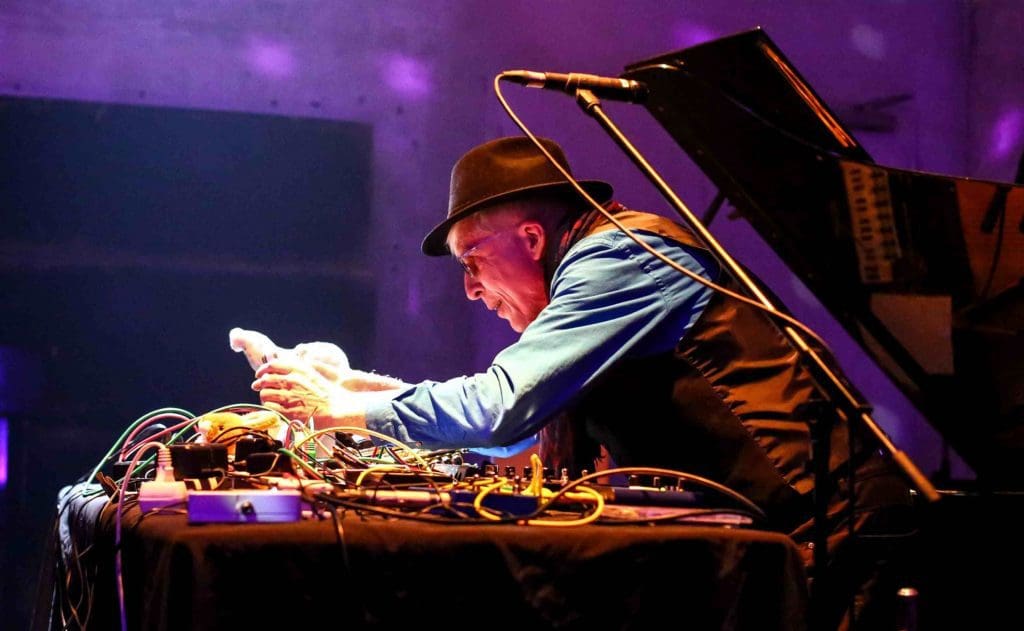A Crash Course in the Works of Chatham, Shea, and Dahl
Next Tuesday FringeArts, in collaboration with the Ars Nova Workshop, hosts one of the most important figures in contemporary music accompanied by two of the most wildly accomplished and versatile musicians working today. The powerhouse trio led by Rhys Chatham, featuring drummer Kevin Shea and bassist Tim Dahl, will delve into the murky sonic depths of post-punk and return with something that will no doubt rock you in your seat (tickets/info). Minds will be blown. Maybe a few ear drums too.
Each of the performers have tirelessly explored so many varied sounds throughout their prolific careers it’s difficult to grasp the breadth of their achievements. Below you’ll find a brief introduction to just some of the boundary-pushing work these three have created over the years.
Rhys Chatham
In 1971 Chatham premiered Two Gongs, one of the best examples of his early work. Featuring Chatham and Fluxus affiliated sound artist/composer Yoshi Wada on a pair of large Chinese gongs, the piece showcases the duo’s incredibly precise and controlled drumming, as well as Chatham’s mastery as a composer. What may seem like an improvisation is actually a carefully calibrated piece, each strike composed and working to achieve the piece’s rapturous effect. It’s hypnotic, it warps your sense of time, it’s really damn loud, and in it one can hear early strains of all noise music to come. Like the ebbs and flows of a raging sea or the chaotic abandon of a blustery storm, the piece tosses about its listeners and leaves them in a state of awe.
By 1976 Chatham’s work began to be shaped by the burgeoning punk rock scene. Chatham began exploring intersections of minimalist composition and punk rock instrumentation which in turn led to his most influential work, Guitar Trio. Consisting of three guitarists, a bassist, and drummer, the piece’s deceptively simple structure belies its unprecedented brilliance. “In this century (the 21st), it has never taken more than an hour to teach G3 to everyone’s satisfaction and comfort level,” Chatham wrote to performers in his 2007 tour of the piece. The framework he lays out for performers provides enough room for each to incorporate touches of their personal style, which has in turn led to more enthralling variations of the piece than would seem possible. It still stands as a perfect entry point to minimalism, punk, and no wave, a genre which Chatham helped kick start.
https://www.youtube.com/watch?v=cDHUtZ4WoE4
A little over a decade after Guitar Trio altered the course of music history, Chatham relocated to Paris and began composing his most ambitious work yet. An Angel Moves to Fast to See is a symphonic tour de force composed for a 100 guitar ensemble that, much like Guitar Trio, echoes minimalism as much as hard rock. Since it’s initial premiere and tour Chatham has composed many other pieces for guitar ensembles of this scale, and in 2007 premiered a 12 hour sonic voyage for a 400 guitar ensemble, but An Angel Moves Too Fast to See still remains one of his most captivating large scale works.
Kevin Shea
With a seemingly endless slew of projects and collaborations, Kevin Shea has been making significant contributions to New York’s free jazz and experimental scenes for over a decade, garnering the distinction of “Best Drummer in New York” in 2012 by the Village Voice. He began his recording career in the avant-garde band Storm & Stress. Borrowing their name from the mid-late 16th century German literary and musical movement Sturm und Drang—in which individual subjectivity and extremes of emotions were valued and given freedom to run wild—it does an excellent job of capturing their unprecedented, cerebral style. At times each performer seems to disappear into their own meditative world, yet there’s a subtle sense of cohesion throughout. It’s clear that if they want to, they can easily pull it all back together into something transcendent, and they always manage to on their own terms.
After the dissolution of the band, Shea got involved in New York’s experimental and avant-garde jazz scenes. He formed the band People with esteemed guitarist Mary Halvorson. Sometimes a duo, sometimes a trio with bassist Kyle Forester, sometimes accompanied by various horns, People gleefully ignores whatever lines exist between free jazz and garage rock, darting back and forth between them until you’re too lightheaded to care. With surreal, self-conscious, and hilarious lyrics the work of People builds on much of the work Shea did for Storm & Stress, blowing up conceptions of rock, jazz, improvisation, and avant-whatever, while giving him an opportunity to exercise his delightfully unhinged sense of humor.
Thanks to Halvorson, Shea became acquainted with Moppa Elliott and his experimental jazz group Mostly Other People Do the Killing. When the drummer they had been rehearsing with couldn’t attend their first gig, Elliott enlisted Shea to sit in. Mid-performance Shea ripped off his shirt and began whipping his drum set with it and in that moment Elliott knew they had found their drummer. Since their founding MOPDtK have released numerous acclaimed albums and toured extensively as the world’s foremost “bebop terrorist band.” Here’s Shea with MOPDtK at the Rotunda, showcasing his performative irreverence and astounding rhythmic chops in an extended drum solo.
Tim Dahl
Much like Shea, Tim Dahl’s prolificacy is staggering. He has been a member of the difficult-to-classify Brooklyn band Child Abuse since 2005. Offering much more than just a controversial name, the band incorporates elements of free jazz, death metal, noise, and strains of many other genres, coalescing them into something wholly their own. “Despite the band’s harsh approach, the presence of thought and structure quickly emerge out of the maelstrom,” the New York Press wrote.
One of Dahl’s most notable collaborations of late has been serving as the bassist for no wave icon Lydia Lunch’s latest project, Lydia Lunch’s Retrovirus. Along with storied sonic brutalizer Weasel Walter and original Sonic Youth drummer Bob Bert, the band seeks to reimagine and reinvigorate songs from Lunch’s immense catalog. But Retrovirus is no mere cover band. Considering the breadth of sounds the indomitable Lunch has explored over the course of her career the musicians’ versatility is remarkable, but what’s more impressive is the way they manage to coalesce all those disparate sounds into something familiar but fresh, at times even managing to eclipse the originals.
Dahl’s dabbling in extreme music led to the 2010 formation of the intense trio Pulverize the Sound. A collaboration between Dahl, MOPDtK trumpeter Peter Evans, and drummer Mike Pride, the group achieves the goal set by their name and then some. Utilizing blistering noise, disorienting repetition, dense walls of sound, silence, and so much more their sound is certainly challenging, but undoubtedly forward-thinking. If their self-titled debut is any indication, the trio is here to help carry the torch set ablaze by seminal free jazz noise shredders Last Exit.
All three of these artists have a wealth of other projects that are well worth your time to explore, but the most pressing is obviously the trio they’ll be bringing to FringeArts next week! Be sure to grab your ticket soon for this rare meeting of masterful musicians.
—Hugh Wilikofsky



